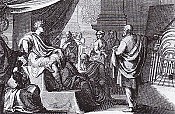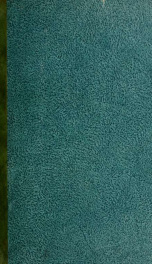Vitruvius Pollio

Marcus Vitruvius Pollio; Vitruvii; (born c. 80–70 BC, died after c. 15 BC) was a Roman writer, architect and engineer (possibly praefectus fabrum during military service or praefect architectus armamentarius of the apparitor status group), active in the 1st century BC. By his own description[1] Vitruvius served as a Ballista (artilleryman), the third class of arms in the military offices. He likely served as chief of the ballista (senior officer of artillery) in charge of doctores ballistarum (artillery experts) and libratores who actually operated the machines.[2] He has been called by some 'the world's first known engineer'.[3] Little is known about Vitruvius' life. His first name Marcus and his cognomen Pollio are uncertain. Cetius Faventinus speaks of "Vitruvius Polio aliique auctores" in his epitome; it is possible that the cognomen derives from this mention by Cetius, meaning Vitruvius, Polio, and others. Most inferences about his life are extracted from his only surviving work De Architectura, though he appears to be known to Pliny the Elder through his description of constructing mosaics [4] in Naturalis Historia, he is not actually named. Frontinus, however, refers to "Vitruvius the architect" in his late 1st century work On Aqueducts (1.25) Likely born a free Roman citizen, by his own account Vitruvius served the Roman army under Julius Caesar with the otherwise unknown Marcus Aurelius, Publius Minidius, and Gnaeus Cornelius. These names vary depending on the edition of De architectura. Publius Minidius is also written as Publius Numidicus and Publius Numidius, speculated to be the same Publius Numisius inscribed on the Theatre of Heraclea[5]. As an army engineer he specialized in the construction of ballista and scorpio artillery war machines for sieges. It has been speculated that Vitruvius served with Julius Caesar's Chief Engineer Lucius Cornelius Balbus[6] The locations where he served can be reconstructed from, for example, descriptions of the building methods of various "foreign tribes". Although he describes places throughout De Architectura, he does not say he was present. His service likely included north Africa, Hispania, Gaul (including Aquitaine) and Pontus. To place the role of Vitruvius the military engineer in context, a description of The Praefect of the camp or army engineer is quoted here as given by Flavius Vegetius Renatus in The Military Institutions of the Romans: At various locations described by Vitruvius, battles and sieges occurred. Of the battlegrounds of the Gallic War there is reference to the siege of Avaricum 52 BC, the Battle of Gergovia 52 BC, the Battle of Alesia 52 BC, and the siege of Uxellodunum 51 BC (all centred on sieges of large Gallic oppida). Of sites involved in Caesar's civil war, we find the Siege of Massilia 49BC,[8] the Battle of Dyrrhachium of 48 BC (Albania), the Battle of Pharsalus 48 BC (Greece), the Battle of Zela of 47 BC (Turkey) and the Battle of Thapsus 46 BC in Caesar's African campaign.[9] A legion that fits the same sequence of locations is the Legio VI Ferrata, of which ballista would be an auxilia unit. During this same time period a Roman military officer Mamurra also served as praefectus fabrum in Hispania, Gaul and Pontus under Julius Caesar. Some have suggested that these two men may be the same, though there is no mention of Caesar's invasions of Britain in De Architectura, nor of other things with which Mamurra was associated, equestrian military practices and personal wealth. Additionally Caesar appears to have outlived Mamurra, whereas Vitruvius dedicated De Architectura to the emperor Augustus. In later years the emperor Augustus, through his sister Octavia Minor, sponsored Vitruvius, entitling him with what may have been a pension to guarantee financial independence.[1] Mainly known for his writings, Vitruvius was himself an architect. In Roman times architecture was a broader subject than at present including the modern fields of architecture, construction management, construction engineering, chemical engineering, civil engineering, materials engineering, mechanical engineering, military engineering and urban planning.[10]Frontinus mentions him in connection with the standard sizes of pipes.[11] The only building, however, that we know Vitruvius to have worked on is one he tells us about,[12] a basilica completed in 19 BC.[13] It was built at Fanum Fortunae, now the modern town of Fano. The Basilica di Fano (to give the building its Italian name) has disappeared so completely that its very site is a matter of conjecture, although various attempts have been to visualise it.[14] The early Christian practice of converting Roman basilica (public buildings) into cathedrals implies the basilica may be incorporated into the cathedral located in Fano. The date of his death is unknown. Vitruvius is the author of De architectura, known today as The Ten Books on Architecture,[15] a treatise written of Latin and Greek on architecture, dedicated to the emperor Augustus. In the preface of Book I, Vitruvius dedicates his writings so to give personal knowledge of the quality of buildings to the emperor. Likely Vitruvius is referring to Marcus Agrippa's campaign of public repairs and improvements. This work is the only surviving major book on architecture from classical antiquity. This text "influenced deeply from the Early Renaissance onwards artists, thinkers, and architects, among them Leon Battista Alberti (1404-72), Leonardo Da Vinci (1452-1519), and Michelangelo (1475-1564)." [16] The next major book on architecture, Alberti's reformulation of Ten Books, was not written until 1452. Vitruvius is famous for asserting in his book De architectura that a structure must exhibit the three qualities of firmitas, utilitas, venustas — that is, it must be strong or durable, useful, and beautiful. According to Vitruvius, architecture is an imitation of nature. As birds and bees built their nests, so humans constructed housing from natural materials, that gave them shelter against the elements. When perfecting this art of building, the Ancient Greek invented the architectural orders: Doric, Ionic and Corinthian. It gave them a sense of proportion, culminating in understanding the proportions of the greatest work of art: the human body. This led Vitruvius in defining his Vitruvian Man, as drawn later by Leonardo da Vinci: the human body inscribed in the circle and the square (the fundamental geometric patterns of the cosmic order). Vitruvius is sometimes loosely referred to as the first architect, but it is more accurate to describe him as the first Roman architect to have written surviving records of his field. He himself cites older but less complete works. He was less an original thinker or creative intellect than a codifier of existing architectural practice. It should also be noted that Vitruvius had a much wider scope than modern architects. Roman architects practised a wide variety of disciplines; in modern terms, they could be described as being engineers, architects, landscape architects, artists, and craftsmen combined. Etymologically the word architect derives from Greek words meaning 'master' and 'builder'. The first of the Ten Books deals with many subjects which now come within the scope of landscape architecture. Books VIII, IX and X form the basis of much of what we know about Roman technology, now augmented by archaeological studies of extant remains, such as the water mills at Barbegal in France. The work is important for its descriptions of the many different machines used for engineering structures such as hoists, cranes and pulleys, as well as war machines such as catapaults and ballistae, and siege engines. As a practising engineer, Vitruvius must be speaking from personal experience rather than simply describing the works of others. He also describes the construction of sundials and water clocks, and the use of an aeolipile (the first steam engine) as an experiment to demonstrate the nature of atmospheric air movements (wind). His description of aqueduct construction includes the way they are surveyed, and the careful choice of materials needed, although Frontinus writing a century later gives much more detail of the practical problems involved in their construction and maintenance. Vitruvius was writing in the first century BC when many of the finest Roman aqueducts were built, and survive to this day, such as those at Segovia and the Pont du Gard. The use of the inverted siphon is described in detail, together with the problems of high pressures developed in the pipe at the base of the siphon, a practical problem with which he seems to be acquainted. His book would have been of great assistance to Frontinus, a general who was appointed in the late first century AD to administer the many aqueducts of Rome. He discovered a discrepancy between the intake and supply of water caused by illegal pipes inserted into the channels to divert the water. He describes many different construction materials used for a wide variety of different structures, as well as such details as stucco painting. Concrete and lime receive in-depth descriptions, the longevity of many Roman structures being mute testimony to the Romans' skill in building materials and design. Vitruvius is well known and often cited as one of the earliest surviving sources to have advised that lead should not be used to conduct drinking water, recommending clay pipes or masonry channels. He comes to this conclusion in Book VIII of De Architectura after empirical observation of the apparent laborer illnesses in the lead foundries of his time. [17] Vitruvius gives us the famous story about Archimedes and his detection of adulterated gold in a royal crown. When Archimedes realised that the volume of the crown could be measured exactly by the displacement created in a bath of water, he ran into the street with the cry of Eureka!, and the discovery enabled him to compare the density of the crown with pure gold. He showed that the crown had been alloyed with silver, and the king defrauded. He describes the construction of Archimedes' screw in Chapter X, although doesn't mention Archimedes by name. It was a device widely used for raising water to irrigate fields and dewater mines. Other lifting machines he mentions include the endless chain of buckets and the reverse overshot water-wheel, a spectacular example of a sequence of such wheels being shown above. Remains of the water wheels used for lifting water have been discovered in old mines such as those at Rio Tinto in Spain and Dolaucothi in west Wales. The former now is shown in the British Museum, and the latter in the National Museum of Wales. The remains were discovered when these mines were re-opened in modern mining attempts.
do you like this author?
What readers are saying
What do you think? Write your own comment on this book!
write a commentWhat readers are saying
What do you think? Write your own comment on this author!
write a commentBook list

An Abridgment of the Architecture of VitruviusContaining a System of the Whole Works of that Author
Series:
Unknown
Year:
Unknown
Raiting:
5/5
Show more
add to favoritesadd In favorites
![Celse, Vitruve, Censorin (oeuvres complètes), Frontin (Des aqueducs de Rome) ; avec la traduction en français [et] publiés sous la direction de M. Nisard_cover](/img/standard/standard_book.png)
Celse, Vitruve, Censorin (oeuvres complètes), Frontin (Des aqueducs de Rome) ; avec la traduction en français [et] publiés sous la direction de M. Nisard
Series:
Unknown
Year:
Unknown
Raiting:
2.5/5
Includes index Traité de la médicine / Celse -- De l'architécture / Vitruve -- Des aqueducs de Rome / Frontin -- Du jour natal / Censorin 26
Show more
add to favoritesadd In favorites
Book list

An Abridgment of the Architecture of VitruviusContaining a System of the Whole Works of that Author
Series:
Unknown
Year:
Unknown
Raiting:
5/5
Show more
add to favoritesadd In favorites
![Celse, Vitruve, Censorin (oeuvres complètes), Frontin (Des aqueducs de Rome) ; avec la traduction en français [et] publiés sous la direction de M. Nisard_cover](/img/standard/standard_book.png)
Celse, Vitruve, Censorin (oeuvres complètes), Frontin (Des aqueducs de Rome) ; avec la traduction en français [et] publiés sous la direction de M. Nisard
Series:
Unknown
Year:
Unknown
Raiting:
2.5/5
Includes index Traité de la médicine / Celse -- De l'architécture / Vitruve -- Des aqueducs de Rome / Frontin -- Du jour natal / Censorin 26
Show more
add to favoritesadd In favorites

De architectura, libri decem: ad optimorum librorum fidem, accurate editi
Series:
Unknown
Year:
Unknown
Raiting:
3/5
Book digitized by Google from the library of Harvard University and uploaded to the Internet Archive by user tpb.
Show more
add to favoritesadd In favorites

M. Vitruvii Pollionis De architectura. Libri decem ad optimas editiones collati. Praemittitur notitia literaria studiis societatis bipontinae. Accedit anonymi scriptoris veteris architecturae compendium cum indicibus
Series:
Unknown
Year:
Unknown
Raiting:
3.5/5
52
Show more
add to favoritesadd In favorites

Dell' architettura di M. Vitruvio Pollione
Series:
Unknown
Year:
Unknown
Raiting:
3/5
Book digitized by Google from the library of the University of Michigan and uploaded to the Internet Archive by user tpb.
Show more
add to favoritesadd In favorites

Dell' architettura di M. Vitruvio Pollione
Series:
Unknown
Year:
Unknown
Raiting:
3/5
Book digitized by Google from the library of the University of Michigan and uploaded to the Internet Archive by user tpb.
Show more
add to favoritesadd In favorites

Vetrvvio con il svo comento et figvre
Series:
Unknown
Year:
Unknown
Raiting:
3.5/5
Title proper reads: Con il svo comento et figvre Vetrvvio. The label "Architettvra" above allegorical figure at head of t.p. is sometimes taken as 1st word of title Imprint from colophon Italian translation of the first 5 of Vitruvius' 10 books. The text, commentary and ill. are arranged as in the 1521 Como ed. (of all 10 books); see Fowler, Mortimer Woodcut t.p. The title within an architectural surround, beneath the allegorical figure of architecture. The border consists of arabesque panels alternating with Caporali's port. and arms, the date M.D.XXXVI, and emblems of mathematics, music, literature and painting. Cut of Bigazzini, at whose private press the book was printed, leaf [2]r Fowler Mortimer, R. Italian 16th cent. Library's c. 1 lacks N2.7 with leaves 99 and 104, having instead two copies of N1.8 with leaves 98 and 105 Binding, c. 1: limp vellum. Title written at head of spine: Vitru- / vio de / Capor. / [fleuron]. Copy 2: limp vellum. Traces of two pairs of ties at foredge, two more at head and foot Inscription on front free endpaper recto, c. 1: Questo Libbro e di Ant:o Buonamici / Comprato in Firenze il di 7: Febbr:o / 1743. Inscriptions at either side of the figure of Architecture on t.p. of c. 2 have been inked out
Show more
add to favoritesadd In favorites

Virtruvius, the ten books on architecture
Series:
Unknown
Year:
Unknown
Raiting:
3.5/5
Book digitized by Google from the library of Harvard University and uploaded to the Internet Archive by user tpb.
Show more
add to favoritesadd In favorites

Virtruvius, the ten books on architecture
Series:
Unknown
Year:
Unknown
Raiting:
3/5
Book digitized by Google from the library of the University of Michigan and uploaded to the Internet Archive by user tpb.
Show more
add to favoritesadd In favorites

The Architecture of Marcus Vitruvius Pollio: In Ten Books
Series:
Unknown
Year:
Unknown
Raiting:
4/5
Book digitized by Google from the library of Harvard University and uploaded to the Internet Archive by user tpb.
Show more
add to favoritesadd In favorites

The Architecture of Marcus Vitruvius Pollio: In Ten Books
Series:
Unknown
Year:
Unknown
Raiting:
3/5
Book digitized by Google from the library of Harvard University and uploaded to the Internet Archive by user tpb.
Show more
add to favoritesadd In favorites

L'architettura di Vitruvio
Series:
Unknown
Year:
Unknown
Raiting:
4.5/5
Book digitized by Google from the library of Harvard University and uploaded to the Internet Archive by user tpb.
Show more
add to favoritesadd In favorites

Vitruvius, the ten books on architecture
Series:
Unknown
Year:
Unknown
Raiting:
4/5
Includes index
Show more
add to favoritesadd In favorites

The architecture of Marcus Vitruvius Pollio : in ten books
Series:
Unknown
Year:
Unknown
Raiting:
4.5/5
Signatures: [a][superscript 4] b-e[superscript 4], B-3G[superscript 4]; 10 leaves of plates "Life of Vitruvius": p. [xvii]-xix Includes index "List of the several editions and versions of Vitruvius": p. [xxi]-xxxi 10
Show more
add to favoritesadd In favorites

M. Vitruvii Pollionis De architectura libri decem
Series:
Unknown
Year:
Unknown
Raiting:
5/5
Imprint from added engraved t.-p "Epitome in omnes Georgii Agricolae De mensuris et ponderibus libros, per Guilielmum Philandrum Castilionium," p. 240-252 "Vitruvii Voluta ionica hactenus amissa. Restituta a Nicolao Goldmanno," p. [265]-272 Woodcut ill., some full page. Head- and tail-pieces, initials Signatures: * +a-+d A-2G 2H chi1 (2I) (2K) ²A-T V ²2I-2K 2L a-i Leaf chi1 unpaged Errata, +d4v Binding: later vellum. Remains of spine label with author & editor in gilt. Edges sprinkled red Bookplate of Biblioteca Giuliari (i.e. Giovanni Battista Giuliari, 1810-1892; see Bragaglia 2094). Giovanni Muzio's bookplate etched by Giacomo Manzù, now covered by process reproduction without the names
Show more
add to favoritesadd In favorites
![Vitruvii De architectura libri decem. Iterum edidit Valentinus Rose. [Bibliotheca scriptorum Graecorum et Romanorum Teubneriana.]_cover](/img/standard/standard_book.png)
Vitruvii De architectura libri decem. Iterum edidit Valentinus Rose. [Bibliotheca scriptorum Graecorum et Romanorum Teubneriana.]
Series:
Unknown
Year:
Unknown
Raiting:
3.5/5
Book digitized by Google from the library of University of Michigan and uploaded to the Internet Archive by user tpb. Mode of access: Internet
Show more
add to favoritesadd In favorites

Dell'architettura di Marco Vitruvio Pollione libri dieci, pubblicati da Carlo Amati 1
Series:
Unknown
Year:
Unknown
Raiting:
3/5
Show more
add to favoritesadd In favorites
What readers are saying
What do you think? Write your own comment on this author!
write a commentif you like Vitruvius Pollio try:
readers also enjoyed
What readers are saying
What do you think? Write your own comment on this author!
write a commentGenre
if you like Vitruvius Pollio try:
readers also enjoyed
Do you want to read a book that interests you? It’s EASY!
Create an account and send a request for reading to other users on the Webpage of the book!

